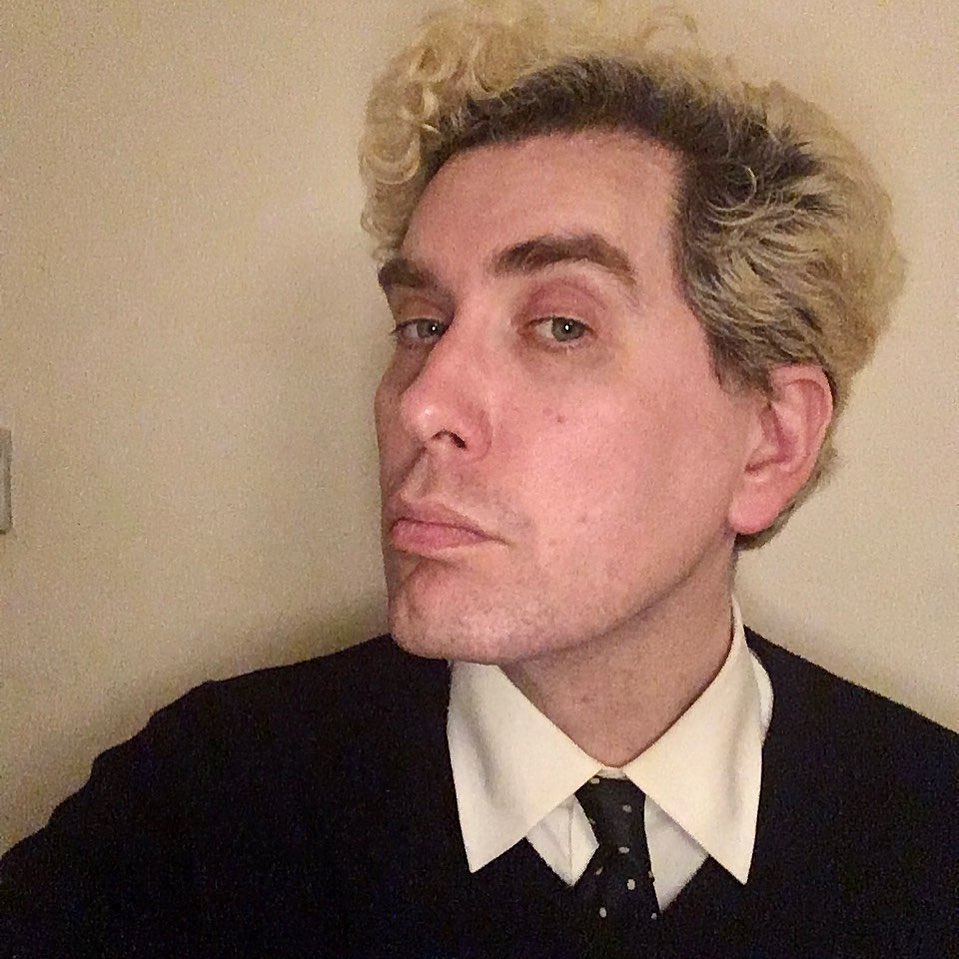
Friday 29 May 2020. We’re all in this together. Except that some of us are more in it than others. The pandemic has exposed everyone’s technological limitations; if you can’t afford super-fast broadband and a decent computer, your lockdown life is going to be rather more locked than others.
My old desktop is dying, and the cheap (£75) mini-PC I bought to replace it can barely run Microsoft Word without stalling. So I finally buy a new laptop. The price is £250, which is the most I can afford. Happily, this just about works for video meetings, a function which for many is now the difference between employment and the dole. I have to spend an arduous volume of time updating the software. One might have thought that someone who had written a diary online for twenty years would be good with computers, or at the very least interested in their workings. But I am entirely incurious. I just want the things to work. And if you’re living on a low budget, things tend to not work. Still, I can speak to Mum via video now. At the beginning of the lockdown, we spoke every day.
*
Sunday 7 June 2020. The schools remain closed. I read a Sunday Times supplement on home schooling. Here, parents are provided with ready-made lessons written by teachers. One lesson on English grammar requires the pupil to identify ‘forward adverbials’. This is aimed at 8-year-olds.
*
Thursday 11 June 2020. A day of relief. I have my PhD funding extended, to allow for the obstacles created by the pandemic. I’ll now remain a full time PhD student until October 2021. By that point I’ll be fifty and (I hope) finishing the thesis. What then? No plans, but then no one knows what the world will be like in late 2021 anyway. The grant is still only £17k a year to live on, but it’s work I enjoy. And it certainly could be worse.
*
Tuesday 13 June 2020. I ‘attend’ an online arts event: a Q & A with the film director Carol Morley. The software encourages you to have your webcam switched on throughout the event, even if you’re not asking a question. I am distracted by seeing the silent faces of the other attendees watching in their various homes. If this were a physical event it would be like letting audience members spend the occasion clambering over the seats, scrutinising each other’s’ faces and demanding them to explain their bookshelves.
*
Wednesday 14 June 2020. I watch You Don’t Nomi, an arthouse documentary about the strange afterlife of the 1990s big-budget film Showgirls. When Showgirls was released it was deemed laughably poor. Since then the film has acquired a cult following, almost on the level of Rocky Horror. It’s a good example of Sontag’s ‘naïve camp’ at play; camp by accident. That said, in this new documentary the Showgirls star and director insist that the whole thing was meant to be tongue-in-cheek from the off. I believe Gina Gershon, one of the other actors, though, when she says she played her role like a drag queen.
We now speak of ‘optics’ – how something looks, though whom to is never quite specified. Something looking ‘bad’ can result in the tainting of a brand, even the sacking of staff.
But not always. Consider our prime minister, a ‘character’ with a strong look, who cares little what people think, as long as they’re looking. This is how camp becomes a weapon. If you make a surface exaggerated enough, it becomes non-stick. Bad films are redeemed with new appeal, bad politicians keep their jobs.
*
Thursday 15 June 2020. One sign of things returning to normal is that today I get a catcall in the street. On Dalston Kingsland High Street I overhear, in my direction: ‘Exterminate! Exterminate! He looks like f–ing…’
I presume they mean Peter Capaldi’s Doctor Who. Particularly in his later episodes, with his hair grown out, looking mad and untamed. He rather anticipated the lockdown look.
*
Tuesday 20 June 2020. My local bookshop, Burley Fisher, has re-opened but cannot let customers inside. Instead they have a table across the entrance. The staff stand behind this, fetching books like a kiosk.
*
Friday 26 June 2020. To Clissold Park for tentative drinks in the park with Ms Shanthi and friends. We try to socially distance, but this turns out to be quite difficult, particularly when we stand under a tree to shelter from the English summer rain. The instinct when in company is always to move closer. After a few drinks, even more so. The fear now is that two’s company, three’s an outbreak. Fun has become a minefield of worry.
*
Wednesday 28 June 2020. People are starting to go on foreign holidays where they can. I can’t share the sentiment: the germ is abroad too. At the moment, I’ll settle for being allowed to visit other parts of London.
*
Monday 6th July 2020. The lockdown has relaxed to the point where the London Library has reopened. This is my idea of civilisation returning. I’m keen to avoid public transport as much as I can, so I begin a new routine of long walks every morning, from Dalston into the city.
In the main reading room of the LL the armchairs have gone. All the desks are carefully marked, with chairs removed at some desks, so that everyone is at least 2 metres apart. I don’t last long in this particular space, though: someone behind me starts coughing.
*
Tuesday 7th July 2020. Haircuts are allowed again. Kommy at Cuts and Bruises, 57 Stoke Newington Road, cuts mine while wearing a clear visor. I wear a mask. Somehow he pins back the straps on my mask to the collar guard, so he can cut the hair around my ears. Colouring appointments are still not available, though, so I bleach my hair myself, using a Jerome Russell ‘B-Blonde No.1’ kit. £5.
*
Wednesday 8 July 2020. The pandemic has meant there’s more bicycles about, along with e-scooters, those powered standing platforms that are suddenly everywhere. The e-scooters manage to look unsafe on both the road and the pavement. I’ve seen a dad take his small daughter to school on one, the child holding onto his legs as he swerves around cars. I suppose that’s an example of risk assessment: avoiding death by virus, at the risk of death by traffic accident.
Each to their own, I suppose, though I resent the way this new trend also endangers pedestrians. Quite often now I find myself close to being hit by an e-scooter or a bicycle going at full speed, even though I am just walking on the pavement.
*
Thursday 9 July 2020. Am sitting in outdoor cafes more often, a new favourite being the one in Red Lion Square Gardens.
The virus has brought out the city in spots. London is covered in circular stickers on the pavement, marking the limits of two metres, or a one-way route, or both.
At the junction of Clerkenwell Road and Grays Inn Road: a sticker on a post: ‘MASKS ARE BAD FOR YOU’.
*
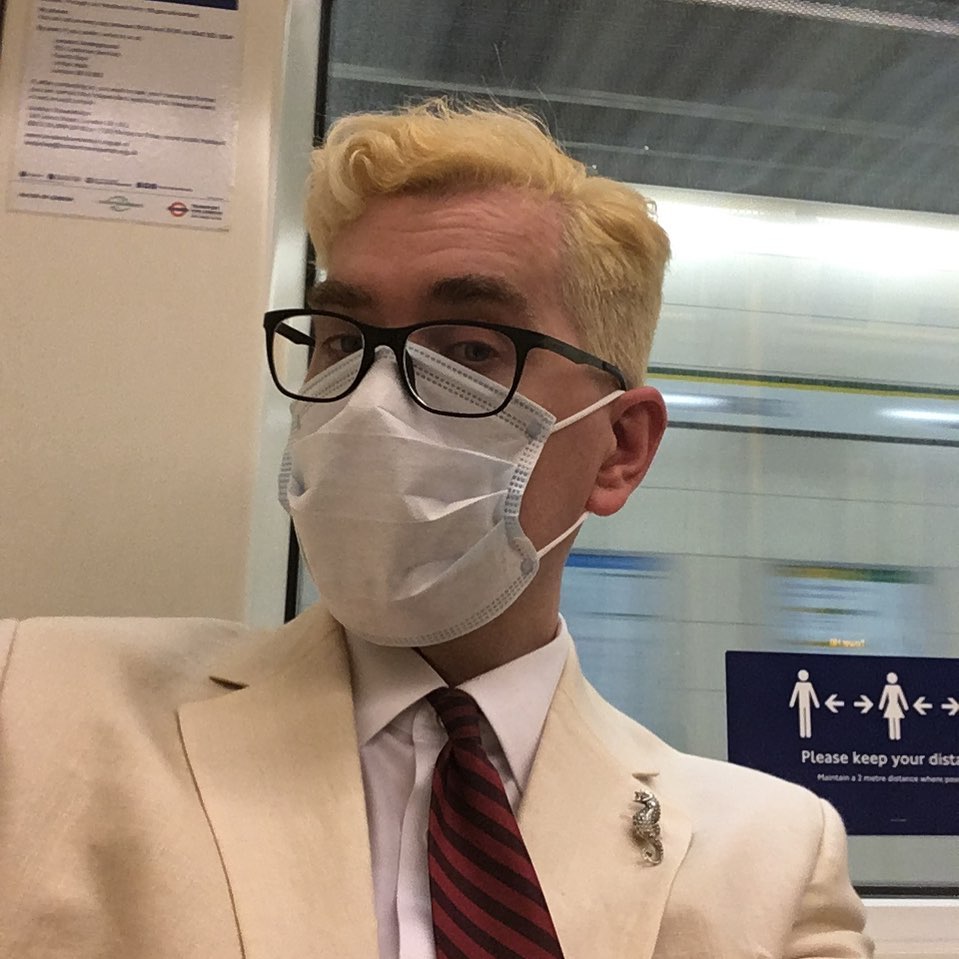
Saturday 11 July 2020. To Vout-o-Reenee’s in Tower Hill for a private view of Sophie Parkin’s paintings. All painted by her during the lockdown. This is my one big social evening out of the summer, though there’s still only a handful of people here, all invited and registered. I enjoy myself, but as with many of my occasional social occasions during the pandemic, I spend subsequent days worrying in case I’ve done something irresponsible.
*
Wednesday 15 July 2020. Much conversation online about the meaning of statues. Something about the invisible nature of a virus has heightened the awareness of more visible cruelties. Statues of slave traders are being pulled down by protesters, most sensationally with the Edward Colston statue in Bristol.
Toppling statues activates their meaning. It blows off the dust. Only then does the ‘valuable history lesson’ that their defenders point to take place. The Colston statue certainly failed to enter my consciousness until now, and I lived in Bristol for three years.
I’m intrigued by the date of the statue: late 1800s, a whole century and a half after his death. So it represents not just Restoration prosperity but also late Victorian anxiety over the end of Empire. And now, the toppling says something about the anxieties of 2020.
*
Friday 17 July 2020. Tickets are released for the reopening of the British Library. Predictably the servers crash at once. It’s Glastonbury for researchers.
*
Saturday 25 July 2020. First time back at the British Library. We’re allocated a specific desk in the reading rooms, but it’s only for three hours maximum per week. And we have to wear a mask.
I manage to stop my glasses fogging up after much initial frustration. What I don’t do is wear a mask with my nose poking out, which many people do as a compromise. Half-arsed faces.
*
Tuesday 28 July 2020. Thinking of Hilary Mantel’s new essay collection Mantel Pieces, I’m now wondering if Shooting an Elephant should have been called Orwell and Good. Against Interpretation could have been Sontag, Bloody Sontag.
*
Thursday 30 July 2020. Something the film director Whit Stillman shares with Angela Carter: they both put seminars on Ronald Firbank in their work (Stillman’s film Damsels in Distress; Carter’s radio play A Self-Made Man).
*
Friday 31 July 2020. Working from home isn’t easy for a lodger. My rented bedroom is not designed to be a full-time office for months on end. Thankfully, Birkbeck have allocated an empty classroom on the Torrington Square campus, in Bloomsbury, to myself and two other full-time PhD students. This will last until the college library reopens in October.
I’m usually the only one in the empty classroom; the security guards have to unlock the room for me specially. There’re so few people in the building, it’s like The Shining. One of the security guards says they’ve had to remove the occasional homeless person from the classrooms.
*
Thursday 6 Aug 2020. At the Museum of London. Some of the displays are still closed off, as they’re in alcoves where socially distancing is impossible. Instead there are barriers with signs saying ‘Please view from here’. With bleak irony, these include the ones on the Black Death.
*
Saturday 8 August 2020. To Enfield to house-sit for Shanthi S. ‘It’s like The Detectorists around here’.
*
Tuesday 18 August 2020. From a documentary on Philip Glass, I learn that the composer has an Allen Ginsberg quotation taped to his piano, by way of motivation. It’s from Memory Gardens (1969):
‘Well, while I’m here, I’ll do the work –
And what’s the Work?
To ease the pain of living.
Everything else, drunken dumbshow.’
*
Weds 19 August 2020. First trip out of London since March, to see Mum. We choose to meet for lunch in Manningtree, a halfway point between Mum and London. I’m still too nervous about going much further out of the city. We eat outdoors in the garden of the restaurant Lucca. As per the advice, we sit at an angle rather than directly facing each other, and we don’t hug or touch.
*
Monday 24 August 2020. The more likely the end of the world, the more I shave and put on a tie.
*
Saturday 29 August 2020. Hurtling towards the age of 49. I ponder the increasing evidence in my face and consider damage limitation. And yet, I don’t want to be one of those men who grow a beard out of sheer resentment at not dying young.
I’m uneasy that I’m still a very odd person. On the plus side, it’s such a comfort.
*
As part of my PhD, I’m consulting the British Library’s archive of Angela Carter’s papers: her unpublished letters, manuscripts and notebooks. I recognise much of the material Edmund Gordon included in his biography The Invention of Angela Carter. One example is the phrase she uses when ending a letter to her partner Mark, written while she was away in America. ‘Please miss me’.
*
Tuesday 1 Sept 2020. To the Rio cinema for Tenet with Jon S. I give up trying to make sense of the premise and just enjoy the nice suits.
*
Thursday 3 Sept 2020. My 49th birthday. I take a solo day trip on the train to Brighton. Quite a lot of people about, albeit with signs advising social distancing, including on the pier. Prosecco dinner in the Palm Court on the pier. I sit in various cafes and bars, including the ‘Loading’ gaming bar on the beachfront. I don’t join in with any of the computer games or board games. I just look on with my glass of wine, a little confused as to how I ended up here or where I’m going next. But happy to still be around.
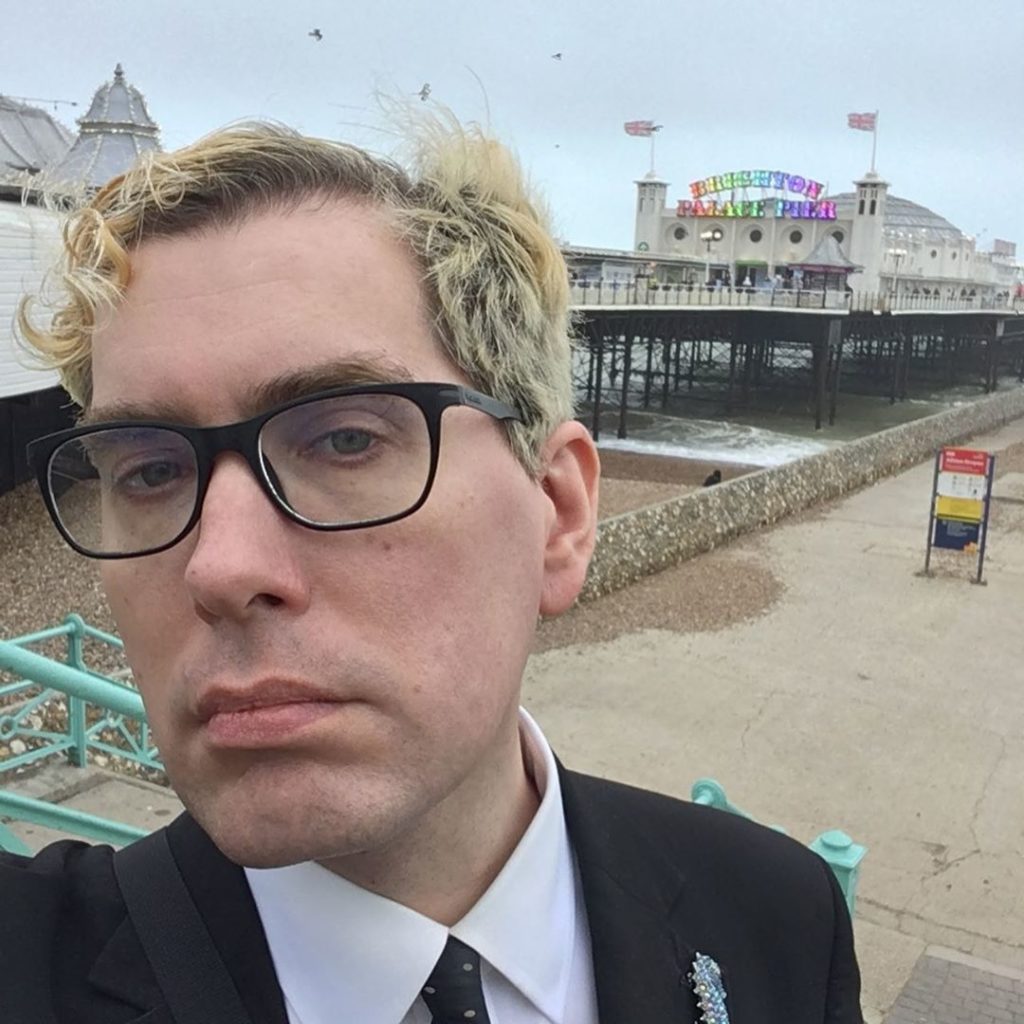
*
Saturday 5 September 2020. At the British Library, I find a note by Angela Carter in one of her journals from the 1980s, all the more amusing given she was once a Booker Prize judge: ‘The Owl of Minerva as a title – from ‘The Owl of Minerva flies at dusk’- Hegel. It’s got a nice, solid, Booker-Prizeish ring to it.’
*
8 September 2020. Life in 2020: seeing an unknown number on the phone and immediately worrying that it’s Track and Trace (it was a wrong number).
*
13 September 2020. A favourite quote, usually attributed to Doris Lessing: ‘Whatever you’re meant to do, do it now. The conditions are always impossible.’ I’ve seen this quote many times, and though I like the sentiment I can’t find any proof that Lessing said these actual words.
‘Do it now’ risks giving Lessing’s name the quality of a Nike ad. Though perhaps that’s the ultimate goal for a writer anyway.
*
Friday 18 September 2020. To Bildeston in Suffolk for dinner at the Crown pub with Mum. This is my third trip out of London since March, and my first to the village I grew up in since last Christmas. We eat outdoors: it’s warm and pleasant. Mum is now making online videos for her classes on quilt-making. She has over two hundred subscribers.
*
Sunday 27 Sept 2020. Reading The Young and Evil, which is so rare I have to refer to a copy at archive.org. Some authors are claiming that archive.org breaches copyright to the point of piracy. They have no idea what a lifeline it’s been to students during the pandemic. I think of the remark made (I think) by Tim Berners-Lee around the time of Napster, with people downloading music. ‘Make it easy for people to do the right thing’.
It’s also like the 1980s campaign, ‘Home Taping Kills Music’. Home taping did the reverse: new generations of people, unable to afford records, were inspired to make music of their own. Why are these lessons never learned?
*
Friday 2 Oct 2020. The National Gallery does Titian face coverings. I wonder what kind of person would buy such a thing. Then I realise it’s me, and buy one.
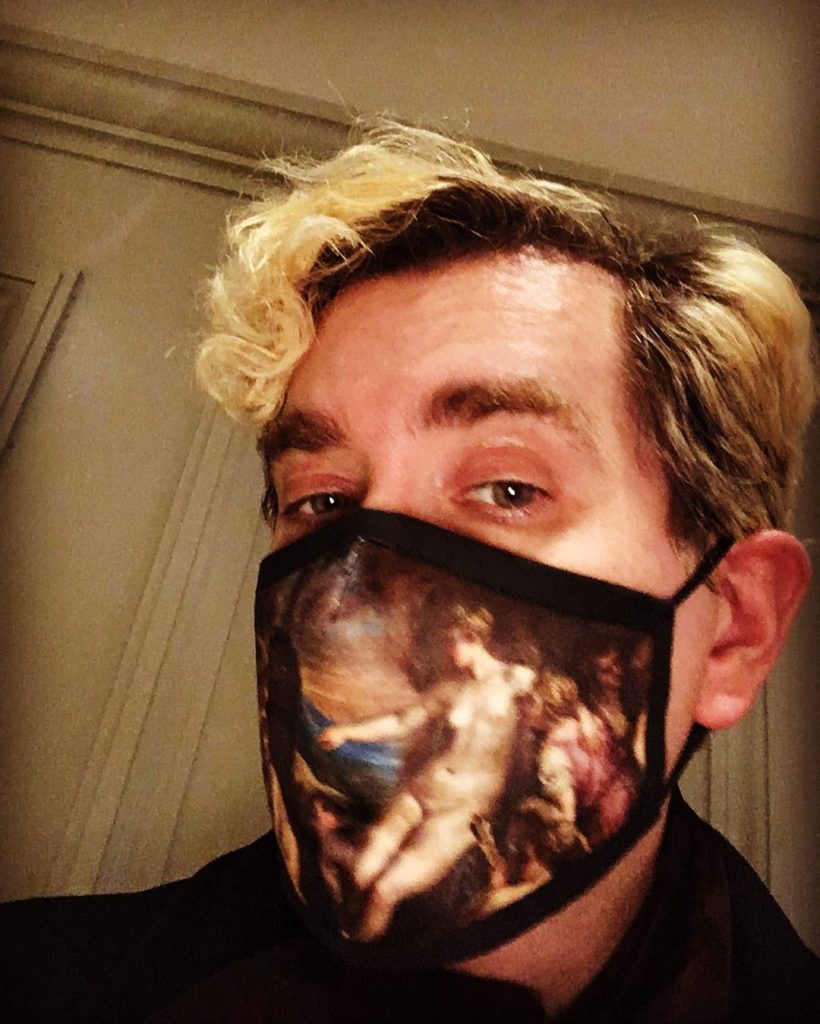
Branded masks are the way forward now. Bands who do t-shirts need to get into masks. If this was 1990, the Inspiral Carpets would be known for selling more masks than records.
*
Tuesday 6 Oct 2020. Dinner with Shanthi S in Pizza Express, Upper Street, Islington. The place is close to empty. Many of the other branches of PE in London have closed temporarily or for good. She takes a couple of photos, giving me the air of an Edward Hopper painting.
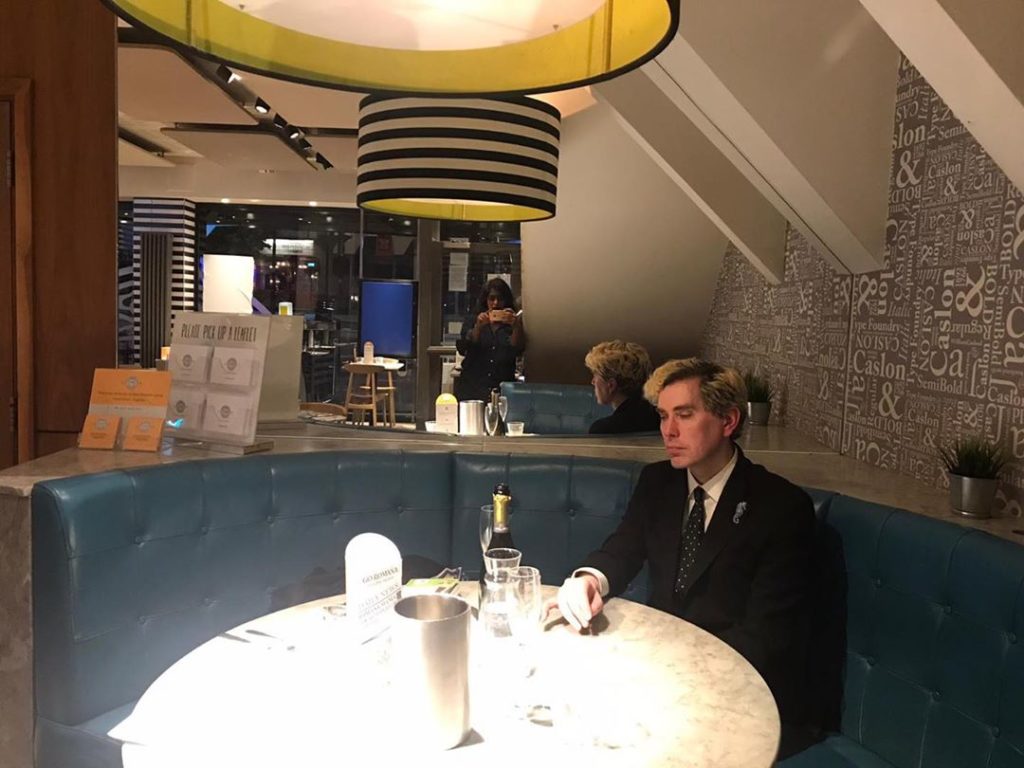
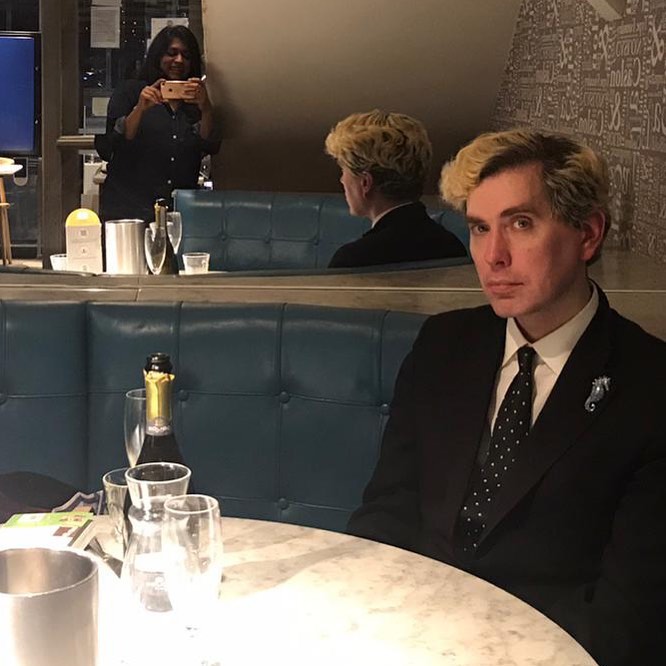
*
Friday 9 Oct 2020. From my bedroom I attend the first online lecture of the new academic year. The lecturer supplies a video recording, seven days in advance, complete with slides and subtitles. Then on the evening itself we can put questions to her live. The lack of being in the same room is a drawback, but being able to pause a lecture and revisit different points is a great help to retaining the information. Something is lost, but something is gained.
*
Tuesday 13 Oct 2020. Mr Johnson announces a ‘three tier’ system for new restrictions, as the coronavirus cases are rising once again. New metaphors take the stage. What might happen now is a short return to lockdown, or a ‘circuit breaker’. What depresses now is the feeling of being trapped in time as much as place. A sense of these things never ending.
*
Thursday 22 October 2020. To the Dalston Rio to see Saint Maud, an arty British horror film. The film is atmospheric and confident, if small in scale. It plays throughout with the question of whether supernatural events are really happening, or whether they’re all in the mind of the protagonist. There’s a good use of an off-season Scarborough, its beach and hills. The lead actor, Morfydd Clark, couldn’t be more different from the last role I saw her in, the dog-wielding Dora in David Copperfield.
The Rio cinema has managed to stay open into the second wave of the pandemic, and tonight there’s a healthy amount of audience, all socially distanced and masked, our temperatures checked on the way in. The nearest rival, Hackney Picturehouse, has closed along with the rest of the Picturehouse and Cineworld chains. The blame has gone on the big studios for postponing the noisier, big-budget titles, such as the new James Bond. This is a time of quieter films, for quieter streets.
**
This online diary was begun in 1997. It is thought to be the longest running of its kind. The archive contains over twenty years of exclusive knowledge, all searchable and free to read without adverts or algorithms or clickbait. It depends entirely on donations by readers to keep it going. Thank you!
Tags: Angela Carter, Archive.org, birkbeck, brighton, British Library, christopher nolan, covid-19, dalston rio, lockdown, London Library, my birthday, saint maud, tenet, The Young and Evil









